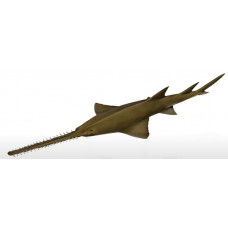Latin name
Anoxypristis cuspidata
Other names
Pointed sawfish, knifetooth sawfish.
Identification
The elongated, flat rostrum is covered with tooth-like projections on both sides. It is covered with electroreceptors that detect the slightest movement of potential prey buried on the ground. The teeth are firmly and deeply anchored in hard cartilage and do not grow back if damaged. The long, lamellar snout has 18 to 25 pairs of teeth on each side. The teeth are short and flat, in the shape of a broad triangle, and there is no furrow on the back edge. Off the north coast of Australia, fish is found with fewer pairs of rostral teeth (18-22). Knifetooth sawfish has more teeth on one side of the rostrum than the other.
The knifetooth sawfish has a slightly flattened, long body. The mouth, nostrils and gill slits are on the ventral surface like other rays. The mouth has small teeth. Behind the small eyes are spatulas that pump water through the gills and allow the ray to lie motionless on the bottom. The skin of adult rays is loosely covered with fine, flat placoid scales, which are densely packed on the back of the head and fins. In embryos and juveniles up to 64.2 cm long, the skin is free of scales. In an individual 71 cm long, scales were present only on the anterior part of the rostrum and along the anterior margin of the fins.
Features of fish fins
There are 2 fairly large dorsal fins of approximately equal size, broad pectoral fins and lower pelvic fins of triangular shape, caudal fin with developed lobes. A developed lower lobe distinguishes these fish from other sawfishes. The anal fin is absent.
Fish colouring
Dorsal surface of body grey, ventral surface pale. Fins light grey. Base of rostrum sometimes dark brown.
Distribution
Inhabit tropical and subtropical waters of the Indo-Pacific from the Persian Gulf to the Indo-Australian Archipelago and north of Japan and South Korea. They are found off the coasts of Australia (Northern Territory, Queensland, Western Australia), Bangladesh, India, Indonesia, Iran, Malaysia, Myanmar, Papua New Guinea and Sri Lanka. In some former habitats, such as off the coast of Vietnam, they are no longer found.
Habitat
Marine; freshwater; brackish; benthopelagic; amphidromous; depth range 0 to 40 m. Tropical; 43°N to 20°S, 30°E to 160°E. Stay in shallow waters close to the bottom, not deeper than 40 m, swim into river mouths and bays, which probably serve as natural nurseries. They can tolerate a wide range of water salinity.
Size
The maximum recorded length is 4.7 metres.
Behavior
They use their snouts to dig for food, injure their prey and defend themselves against predators, which in the natural environment are large sharks. Their "saw" is dotted with electroreceptors that help them detect prey in murky water. Their serrated rostrum makes them very vulnerable - they can become entangled in nets and floating debris.
Food and feeding habits
They feed on crustaceans, molluscs and small fish.
Reproduction
They reproduce by oviparity. Fertilisation is internal, the embryos develop in the womb and feed on egg yolk. There are 6-23 young in a litter, 50-80 cm long. Their rostral denticles are sheathed and reach their final size in relation to the rostrum only after birth. Pregnancy lasts approximately 5 months. Males and females reach sexual maturity at 200 and 230 cm respectively. The age of sexually mature individuals is estimated to be 2-3 years.
Fishing
The object of commercial fishing.
Relationship with a person
The meat of these fish, especially the fins, which are an ingredient in the famous soup, is highly prized. The liver fat is used in folk medicine. The price of a rostrum can reach $1,000 or more.
| Classification | |
| Phylum | Chordata |
| Class | Actinopterygii |
| Squad | Rhinopristiformes |
| Family | Pristidae |
| Genus | Anoxypristis |
| Species | A. cuspidata |
| Features | |
| Conservation status | Critically Endangered |
| Habitat | Bottom |
| Life span, years | No information |
| Maximum body weight, kg | No information |
| Maximum length, cm | 470 |
| Sailing speed, m/s | No information |
| Threat to people | Edible |
| Way of eating | Predator |
Knifetooth sawfish
Tags: knifetooth sawfish

